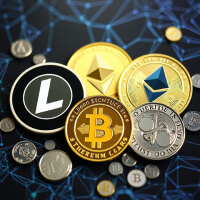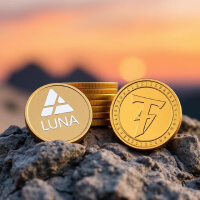In the universe of cryptocurrency, there is not just Bitcoin-the most famous digital asset-but a myriad of other coins and tokens. Predominantly among these are two categories: altcoins and stablecoins. Both have different characteristics and, most importantly, functions. For one to confidently enter the world of digital currencies, one has to understand these differences. The article will discuss altcoins and stablecoins, their roles, and how different they are from each other.
What Are Altcoins?
Short for "alternative coins," altcoins are any cryptocurrencies that are not Bitcoin. With the entry of Bitcoin in 2009 in the system, it had the exclusivity of the digital currency. But as the ecosystem of digital currencies was expanding, more programmers created new coins with features that they thought may patch Bitcoin's perceived shortcomings, or provided for some unique functions. Thus an altcoin may have its own blockchain or, below it faintly either by using the premise of Bitcoin or Ethereum blocks, through smart contract technologies.

Types of Altcoins
There are different types of altcoins, each with varied uses and purposes. The more common ones include:
- Litecoin (LTC): Referred to as the "silver in the presence of Bitcoin's gold," Litecoin has faster transaction times whilst providing a different hashing algorithm (Scrypt) for better accessibility.
- Ethereum (ETH): More than a digital currency, Ethereum introduced smart contracts whereby decentralized applications (dApps) could actually run on the blockchain.
- Ripple (XRP): XRP offers speedy and cost-effective cross-border payments. It has its eyes on the global payment system.
- Privacy Coins (like Monero, Zcash): These coins provide more privacy features in disguise of transaction details to maintain anonymity.
- Tokens (ERC-20, BEP-20): These cryptocurrencies exist on the blockchain of other cryptocurrencies, such as Ethereum (ERC-20) or Binance Smart Chain (BEP-20), often utilized for DeFi applications.

Why Do People Invest in Altcoins?
It goes without saying that altcoin investors look for investment opportunities that seem to provide a much bigger growth opportunity more than Bitcoin. Being relatively established, Bitcoin can rarely offer bigger rewards, so altcoins come with bigger possibilities but equally big risks. Altcoins attract those who want some use case, whether it is for privacy, smart contracts, or decentralized finances.
What Are Stablecoins?
The idea behind a stablecoin is to have a cryptocurrency with a stable price being pegged to a fiat currency, often the U.S. Dollar or a basket of goods. Such price stability makes stablecoins pertinent to being utilized for commercial purposes and storage of value, especially with the high volatility around cryptocurrencies. In simple words, stablecoins try to fix one major downside of cryptocurrencies-high volatility.

Types of Stablecoins
There are basically three types of stablecoins, each with different systems for maintaining stability.
- Fiat-collateralized Stablecoins: Fiat money-backed stablecoins are kept secure by holding collateral in fiat currency counterpart at a reputed bank or institution. For it, Tether (USDT) is offered as an example, which is pegged one to one to the U.S. Dollar. For each USDT token that is issued out, an equal amount of USD is held by the reserve in bank.
- Crypto-collateralized Stablecoins: The backing for these stablecoins is in other cryptocurrencies. Because of the volatility of cryptocurrencies, these stablecoins are usually over-collateralized to ensure their stability. An example is DAI, which is collateralized by Ethereum and other tokens.
- Algorithmic Stablecoins: These stablecoins are not dependent on collateral but use algorithms to manage the supply of coins to keep the price constant. Terra (LUNA), for example, tried to maintain its peg to the U.S. Dollar via an algorithmic mechanism but failed and collapsed in 2022.

Why Do People Use Stablecoins?
Stablecoins have many uses:
- Safe Haven From Volatility: Investors and traders resort to stablecoins to protect themselves from the high volatility usually exhibited by altcoins. They can simply transfer their holdings into stablecoins when a bear market is around to retain value.
- Aide to Transactions: They are used for transactions in the cryptocurrency ecosystem because their price remains stable. For example, most decentralized finance (DeFi) platforms use stablecoins to lend, borrow, and trade.
- Cross-border Transactions: They serve to move money fast and cheap across the borders, wastefully slow and expensive using the traditional banking systems.
Key Differences Between Altcoins and Stablecoins
Falling off the same family of cryptocurrency, both altcoins and stablecoins differ across their purpose in the universe of cryptocurrencies. Below we will add a few key differences between them:

Purpose and Use Case
- Altcoins: Generally speaking, altcoins are developed to present alternative digital currencies or platforms with certain construction features, for example, fast transaction speeds, greater privacy, or the capability to run dApps. In many cases, they either work as a medium of exchange or interact with decentralized platforms.
- Stablecoins: The main function of a stablecoin is exactly that: stability-in the sense of a dependable store of value. They act as a haven asset for the short-term within the highly volatile crypto market by traders and investors; similarly, it is used for transferring value without exposure to price risk.

Volatility
- Altcoins: Primarily, altcoins are volatile instruments. By mechanisms of sudden sentiment changes, sudden spread of news, or sudden technological changes, prices may be wildly erratic. Therein lies the opportunity for altcoins: because the price caters to huge returns, altcoin also harbors risks in equal measure.
- The Stablecoins: As the name suggests, they were created to serve stability. The very concept of value pegged to stable assets like the U.S. Dollar makes them much less prone to the kind of insane fluctuations that altcoins go through.

Backing Mechanism
- Altcoins: Most altcoins run on their own blockchain or use others like Ethereum and Binance Smart Chain. Depending on demand or technological considerations, altcoins are valued for their potential application.
- Stablecoins: Stablecoins serve as collateral-backed by fiat currencies like USD or EUR, cryptocurrencies like ETH, or algorithms. This collateralization guarantees the prevalence of their stability, unlike altcoins whose price is dictated by the free forces of market dynamics.

Investment Technique
- Altcoins: Buying these is considered usually a high-risk, high-reward strategy. Investors seek coins that could outperform Bitcoin or provide unique solutions in the cryptocurrency ecosystem, hence failing altcoins are suited for those willing to take risks in pursuit of rewards.
- Stablecoins: Stablecoins are more for hedging or keeping liquidity within the crypto ecosystem. They are considered a safer option by those investors who want to get out of the market fluctuations of other cryptocurrencies, or by users who just want a digital currency with a steady value for transactions.
Summary
Altcoins are the innovators, providing legitimate opportunities for major returns imposed by the constraints of technology and a very specialized use case. In stark contrast, stablecoins add stability and security as an option in which an investor may protect his funds and cross transfer without worrying about fluctuations in the market.
Knowing these things will help you understand where to put your resources based on your risk appetite, investment goals, and position you want to play in the crypto world.
Read More
$KAS solved the blockchain trilemma
— Sukie (@bySukie) July 27, 2025
Proof of Work, Nakamoto consensus, decentralized, secure & scalable.
Im bullish on Kaspa. 💚 pic.twitter.com/5BxsdHTz9w
Bitcoin has reached gold parity. 1 Kg of Gold Now Costs Same as 1 BTC. 🚀#Bitcoin #crypto #blockchain #cilionaire #cryptocurrency #crypto #cryptocurrencies #cryptotrading #cryptonews #cryptoming pic.twitter.com/mfHDne2j9z
— Mohini Of Investing (@MohiniWealth) July 28, 2025